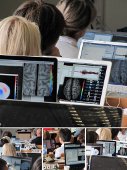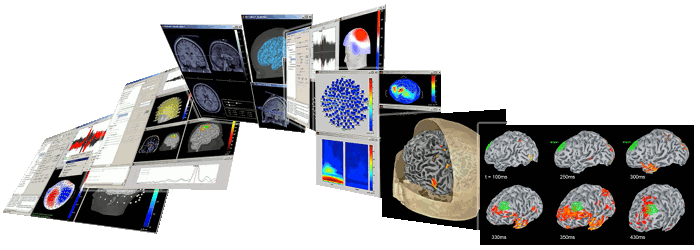|
Size: 8882
Comment:
|
Size: 10258
Comment:
|
| Deletions are marked like this. | Additions are marked like this. |
| Line 1: | Line 1: |
| <<HTML(<div style="margin-top: 15px; padding: 0px; border: 0px solid #999; float: right; width:310px; "><TABLE Border=0 style="background-color: #f7f7f7;"><TR><TD colspan=2><A href="http://neuroimage.usc.edu/brainstorm/Training">New Brainstorm courses: Register now!</A></TD></TR><TR><TD><B>Boston: </B></TD><TD>April 28, 2012 (FULL)</TD></TR><TR><TD><B>Montreal: </B></TD><TD>July 11, 2012</TD></TR><TR><TD><B>Paris: </B></TD><TD>August 31, 2012</TD></TR></TABLE></div>)>> {{attachment:logo_bloc.gif|logo_line.gif}} |
{{attachment:logo_line.gif}} |
| Line 6: | Line 4: |
| * '''1st Brainstorm-users Symposium & Training'''<<BR>>Satellite of Biomag2012; Paris, August 31, 2012<<BR>>[[WorkshopBiomag2012|Call for papers & registration]] | <<HTML(<!-- div style="margin-top: 5px; padding: 0px; border: 0px solid #999; float: right; width:310px; "><TABLE Border=0 style="background-color: #f7f7f7;"><TR><TD colspan=2><A href="http://neuroimage.usc.edu/brainstorm/Training">Next Brainstorm course moved to larger venue: Register now!</A></TD></TR><TR><TD><B>Paris: </B></TD><TD>August 31, 2012</TD></TR></TABLE></div -->)>> <<HTML(<! div style="margin-top: 0px; padding: 0px; border: 0px solid #999; float: right; width:220px; "><a href="http://www.facebook.com/media/set/?set=a.287879241316067.56071.117589778345015&type=3"><img align="right" alt="Biomag 2012" class="attachment" src="/brainstorm/Introduction?action=AttachFile&do=get&target=ParisBrainstormCourse_small.jpg" title="Biomag 2012" /></a></div>)>> |
| Line 9: | Line 10: |
| * '''<<HTML(<FONT color=red>)>>'''Just announced''<<HTML(</FONT)>> New training opportunity (Montreal, December 6, 2012)''':<<BR>>[[WorkshopNeuro2012|Register now!]] | |
| Line 10: | Line 12: |
| == The Brainstorm project == {{attachment:brainstorm_banner.gif||height="209px",width="586px"}} |
== About Brainstorm == . {{attachment:brainstorm_banner.gif||height="209px",width="586px"}} |
| Line 15: | Line 17: |
| Our objective is to share a comprehensive set of user-friendly tools with the scientific community using MEG/EEG as an experimental technique. For physicians and researchers, the main advantage of Brainstorm is its rich and intuitive graphic interface, which does not require any programming knowledge. We are also putting the emphasis on practical aspects of data analysis (e.g., with scripting for batch analysis and intuitive design of analysis pipelines) to promote reproducibility and productivity in MEG/EEG research. Finally, although Brainstorm is developed with Matlab (and Java), it does not require users to own a Matlab license: an executable, platform-independent''' ''' (Windows, MacOS, Linux) version is made available in the [[Download|downloadable package]]. | Our objective is to share a comprehensive set of user-friendly tools with the scientific community using MEG/EEG as an experimental technique. For physicians and researchers, the main advantage of Brainstorm is its rich and intuitive graphic interface, which does not require any programming knowledge. We are also putting the emphasis on practical aspects of data analysis (e.g., with scripting for batch analysis and intuitive design of analysis pipelines) to promote reproducibility and productivity in MEG/EEG research. Finally, although Brainstorm is developed with Matlab (and Java), it does not require users to own a Matlab license: an executable, platform-independent''' ''' (Windows, MacOS, Linux) version is made available in the downloadable package. |
| Line 25: | Line 27: |
| == Support == This software was generated primarily with support from the '''National Institutes of Health''' under grants R01-EB002010, R01-EB009048, and R01-EB000473. Primary support was provided by the '''Centre National de la Recherche Scientifique''' (CNRS, France) for the Cognitive Neuroscience & Brain Imaging Laboratory (La Salpetriere Hospital and Pierre & Marie Curie University, Paris, France), and by the '''Montreal Neurological Institute''' to the MEG Program at McGill University. Additional support was also from two grants from the '''French National Research Agency''' (ANR) to the Cognitive Neuroscience Unit (PI: Ghislaine Dehaene; Inserm/CEA, Neurospin, France) and to the ViMAGINE project (PI: Sylvain Baillet; ANR-08-BLAN-0250), and by the Epilepsy Center in the Cleveland Clinic Neurological Institute. |
|
| Line 32: | Line 41: |
| * Read data from the most popular file formats ([[#line-78|listed here]]); can import from multiple ASCII files as well | * Digitize the position of the EEG electrodes and the subject's head shape using a Polhemus device * Read data from the most popular file formats ([[#line-78|listed here]]) |
| Line 91: | Line 101: |
| * Time-frequency analyses of sensor data and sources time series using Morlet wavelets | * Time-frequency analyses of sensor data and sources time series using Morlet wavelet, Fast Fourier Transfor, and Hilbert transform |
| Line 113: | Line 123: |
| * BDF / BDF+ (Biosemi 24bit binary) | |
| Line 114: | Line 125: |
| * !BrainAmp (.eeg) | * !BrainVision !BrainAmp (.eeg) * !BrainVision Analyzer (.txt) |
| Line 116: | Line 128: |
| * EDF / EDF+ | * EDF / EDF+ (European Data Format) |
| Line 119: | Line 131: |
| * MANSCAN Microamp (.mbi/.mb2) | |
| Line 152: | Line 165: |
| * FSL: VTK (*.vtk) * FSL: Geomview (*.off) |
* FSL: VTK (.vtk) * FSL: Geomview (.off) |
Latest software updates :
http://neuroimage.usc.edu/brainstorm/NewsJoin the Brainstorm community now :
facebook.com/BrainstormSoftwareJust announced:
Register now!
About Brainstorm
Brainstorm is a collaborative, open-source application dedicated to magnetoencephalography (MEG) and electroencephalography(EEG) data analysis (visualization, processing and advanced source modeling).
Our objective is to share a comprehensive set of user-friendly tools with the scientific community using MEG/EEG as an experimental technique. For physicians and researchers, the main advantage of Brainstorm is its rich and intuitive graphic interface, which does not require any programming knowledge. We are also putting the emphasis on practical aspects of data analysis (e.g., with scripting for batch analysis and intuitive design of analysis pipelines) to promote reproducibility and productivity in MEG/EEG research. Finally, although Brainstorm is developed with Matlab (and Java), it does not require users to own a Matlab license: an executable, platform-independent (Windows, MacOS, Linux) version is made available in the downloadable package. Since the project started by the end of the 1990's, our server has registered more than 7,000 accounts and about 500 users are actively updating the software. See our reference page for a list of published studies featuring Brainstorm at work! The best way to learn how to use Brainstorm, like any other academic software, is to benefit from local experts. However, you may be the first one in your institution to consider using Brainstorm for your research. We are happy to provide comprehensive online documentation and support throughour forum but there is nothing better than a course to make your learning curve steeper. Consult our training pages for upcoming Finally, have a look regularly at our What's New pages for staying on top of Brainstorm news and updates and 'Like Us' on Facebook to stay in touch. We hope you enjoy using Brainstorm as much as we enjoy developing and sharing these tools with the community!
This software was generated primarily with support from the Primary support was provided by the Additional support was also from two grants from the
Please cite the following reference in your publications if you have used our software for your data analyses: How to cite Brainstorm. It is also good offline reading to get an overview of the main features of the application. Tadel F, Baillet S, Mosher JC, Pantazis D, Leahy RM (2011), Brainstorm: A User-Friendly Application for MEG/EEG Analysis,
Read data from the most popular file formats (listed here) Import MRI volumes and tessellated surface envelopes from most of the existing file formats (listed here) Detailed step-by-step tutorials for most common features
MRI segmentation: Use FreeSurfer, BrainSuite or BrainVisa. ?See here.
BrainVision BrainAmp (.eeg) BrainVision Analyzer (.txt) EGI NetStation epoch-marked file (.raw/.epoc)
BrainSuite (.dsgl, .dfs) FreeSurfer

Support
How to cite Brainstorm
What you can do with Brainstorm
MEG/EEG recordings: What you cannot do with Brainstorm (yet)
Supported file formats
EEG:
MEG:
Sensors locations:
MRI volumes:
Surface meshes:
Noise statistics (sensor covariance arrays):
Dipole models:



